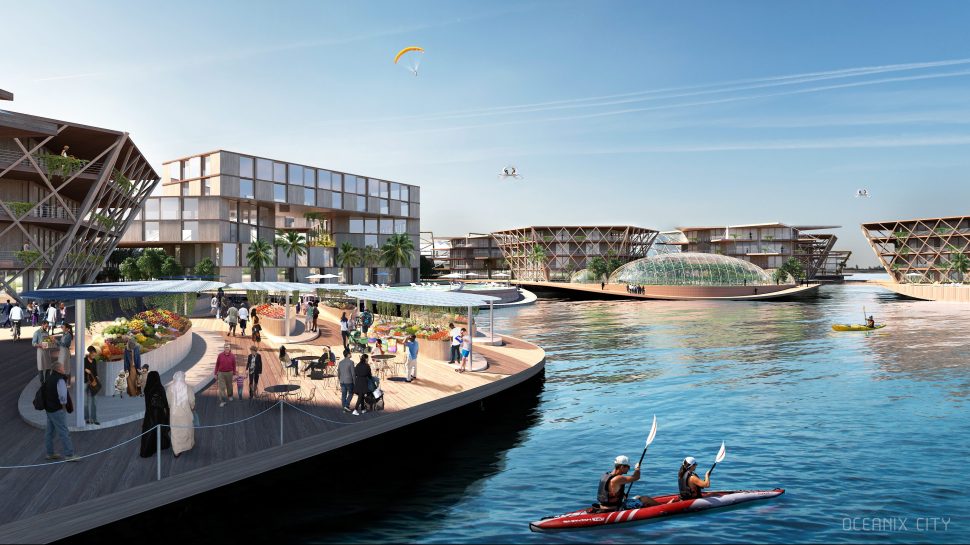Back in 2008, the famously right-wing PayPal founder Peter Thiel threw money at the idea of a floating city — a sort of drifting Mar-a-Lago, where the rich could escape tax-free to a virtually lawless paradise. But after pushback from Pacific Islanders who called the plan a form of colonialism, crucial partners abandoned ship, and by 2017, Thiel’s libertarian wet dream was dead in the water.
Now, the idea of seaborne cities has been floated again — this time, as a haven for climate refugees chased out of their homes by rising seas and supercharged cyclones.
Dreamed up by Marc Collins Chen, an entrepreneur who was involved with efforts to bring Thiel’s vision to French Polynesia, the plan was rolled out at a United Nations roundtable last week — complete with luxe architectural renderings from the Brooklyn- and Copenhagen-based Bjarke Ingels Group. U.N. representatives lauded the idea as a forward-looking solution, but for some, this latest incarnation of Thiel’s dream is still lost at sea. (Think I can’t keep these water puns going? Batten down the hatches…)
Designed to house 10,000 people, Oceanix City, as it’s called, is a self-sustaining cluster of islands fit for an Instagram honeymoon. There are vertical farms, underwater seafood-harvesting cages, and aquaponics systems fertilized by fish poop (every newlywed’s dream!). It’s got the power to extract potable water from the air, and its island components can be rearranged for optimal heating and cooling across seasons. Garbage is whisked away in pneumonic trash-tubes. There’s nary a car in sight.

OCEANIX / BIG-Bjarke Ingels Group
It’s like a resort you’d see in a targeted ad after searching for at-home compost bins and biodegradable bikinis — and U.N. Deputy Secretary-General Amina Mohammed didn’t waste any time hopping on board.
“As our climate and water ecosystems are changing, the way our cities relate to water needs to change, too,” Mohammed said in a prepared remark at the proposal’s unveiling. “Today, we are looking at a different type of floating city — a different type of scale.”
But do floating cities really hold water as an option for some of the planet’s most vulnerable?
Collins Chen, whose company Oceanix is behind the proposal, insists that the city could be built to be affordable. He points out that you don’t have to buy any expensive land to build it. And while there’s not a ton of precedent for buying offshore acreage, some wind-power companies have leased it from the U.S. government for around $3 per acre per year. Collins Chen also says some governments he’s spoken with have floated the idea of subsidizing floating city projects that include floating affordable housing (you might have to come up for air after that one). Plus, the city is designed to be modular and built off-site, which decreases typical building inefficiencies.
“It has to be an affordable option, or we’re not interested,” Collins Chen said. (He didn’t mention how refugees would be able to afford the sea kayaks and dockside dining.)

OCEANIX / BIG-Bjarke Ingels Group
Still, Oceanix hasn’t put a price tag on the project, in part because there’s no location set for a prototype. Collins Chen says that reports of plans for one on New York’s East River aren’t true (also not quite true, he says, are claims that the city is built to withstand a Category 5 hurricane — “some of your windows may [be] blown out”). Depending on where Oceanix City ends up, the cost of labor and materials used to construct it could vary greatly, and so could the cost to live there, according to Alana Goldweit, project manager of Oceanix City for Bjarke Ingels Group.
But even if Oceanix manages to create an affordable floating city, some critics trashed the proposal as essentially marooning climate refugees — primarily low-income people of color, who are most often on the frontlines of climate change — on manufactured islands.
“I was a little surprised to see [Oceanix City] received so eagerly by the folks at the U.N.,” says Billy Fleming, director of the University of Pennsylvania’s McHarg Center for Urbanism and Ecology. “I think it says a lot about the depth of thought that was put into this proposal that the big idea is to take all of our poorest, most vulnerable people — climate refugees — and stick them on an island that’s out of sight and out of mind.”
The designers of Oceanix City imagine it floating about a mile away from coastal megacities, putting it a theoretical 5- or 10-minute boat ride from civilization (or, if you’re going by their renderings, just a quick jaunt by hovercraft). But Fleming says that climate refugees would be better served by public and affordable housing in and around existing communities like the ones they’re already fleeing to — including New York and Philadelphia, which are currently working to house refugees from Puerto Rico in the ongoing aftermath of Hurricane Maria.
“We’re finding ways to free up affordable housing stock and other housing for them so that, for as long as they want to be here, they can have a full and happy life,” Fleming says. “No one is proposing to put them on an island in the Atlantic Ocean.”
But for Collins Chen, that doesn’t sound so bad — he lived in Tahiti for most of his life, and served as the Minister of Tourism in French Polynesia before moving to New York City. While Oceanix City could be an option for climate refugees around the world — and was certainly marketed that way at the U.N. roundtable — Collins Chen says he initially imagined it as a way for people in island communities to stay close to home. The alternative, he says, is some sort of “managed retreat,” where residents migrate inland, or to other places altogether, as sea levels rise.
“In French Polynesia, ‘managed retreat’ is a dirty word,” Collins Chen says. “You don’t just want to abandon somewhere where you buried your ancestors.”
It gets to the crux of coastal climate adaptation: What works well for one community may not work at all for another. Take living shorelines, which use natural elements like stones or oyster reefs to stabilize banks and absorb storm surges — they’ve been held up by some as the gold standard for combating sea level rise, but they work best in sheltered tidal areas. New Jersey’s Atlantic City may decide not to combat sea level rise at all, instead serving as a living laboratory for climate change’s effects on coastal cities — noble enough, but like most things in Atlantic City, probably not a viable option for everyone.
And at a time when a lot of cities haven’t found their ideal climate adaptation plan — many involve building or expanding seawalls, an expensive choice that can destroy habitats, erode the shoreline, and even reroute rising waters to other communities — it might be worthwhile to add another lifeboat to the vessel.
Anyway, unless someone reverses climate change before lunch tomorrow, we’re locked into a certain amount of warming and sea-level rise, and we’re going to see increased numbers of climate refugees. What will really make a difference, according to Fleming, is making sure that equity and justice come first when we’re figuring out what to do about it.
“The thing that design and planning folks can offer to this moment is to think about what we can do right now, from an infrastructure and built-environment perspective, that can buy people time, keep them where they are longer, give them a higher quality of life for longer, and give them agency and control over what happens next,” Fleming says.
If that sounds like what Collins Chen thinks his floating cities could do for people in island communities, it basically is. And in that light, Oceanix City, or something like it, might be a more logical and just idea than it first appears. At the very least, it’s making waves.


